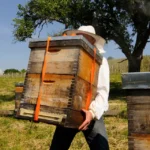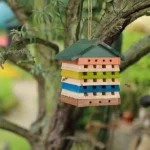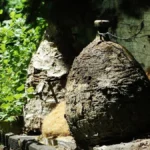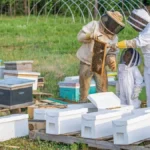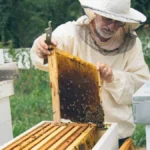How much do beehives cost? This is like asking how much cars cost! In this article we look at the cost of beekeeping, the beehive price options – from a Rolls Royce beehive all the way down to the scrapyard spares model you can make yourself. The price of your hives influences the overall cost of beekeeping. Knowing your options helps you with your beekeeping business plan. It is also important to remember that buying cheap, is often expensive. We will go into that in detail.
What Is A Beehive?
A beehive is anything bees build a nest in. It can be an old tyre, all the way through to a very fancy beehive that measures temperature, weight, bee activity, etc. For the sake of simplicity in this article, we will call a Beehive a Langstroth Beehive type box in which bees can be kept.
How Much Do Beehives Cost?
There are a number of options for a beehive. For simplicity, we will cost a brood box, bottom board, frames, two supers and a lid.
DIY Beehive Option
You can download the dimensions for a Langstroth hive here. If you have a reasonably well-equipped workshop, you can make some nice beehives. Useful tools are a table saw, a thickness planer to size timber to the right size so that you get your bee space perfect.
My general advice is to choose a light softwood timber – pine or cedar is good. Buy untreated wood – you do not want to have any poisons in the wood getting into your bees. Choose wood with as few knots in as possible.
I used to run a sawmill to actually cut the timber for our hives, and we would choose the clearest timber possible, and sell the timber with knots on to people who like such things. A knot invites trouble in your hive. Knots often jump out making a hole in the box, or, if they are in the frames, they will make weak spots that break or warp.
Depending on what you pay for the timber you buy look at a cost of not more than $50 or so per hive. If you scratch around at a sawmill and buy offcuts, you can probably build a hive for under $10 in timber. The expensive bit will be the screws to hold it together.
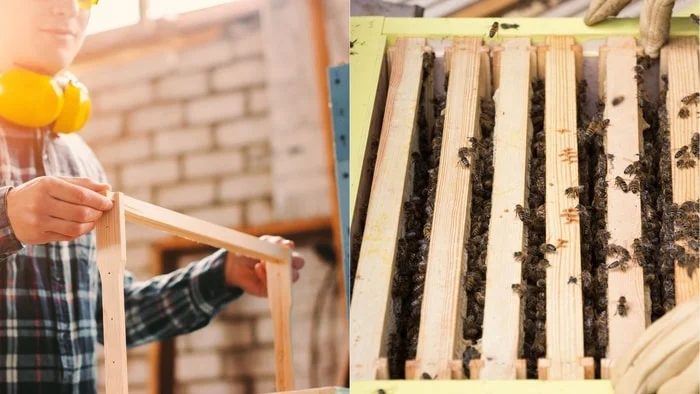
Learn more about: Beehive Frames Without Foundation
Unless you are a really good carpenter, rather buy a flat pack box for your first few hives. Getting a hive slightly wrong, and then keeping bees in it and ending up with a mess is depressing. Learn one new skill at a time.
Flat Pack Box To DIY Assemble
Many manufacturers will ship a flat-pack beehive box pack. This consists of all the bits and pieces you need and you can assemble your own hive. I would recommend this route if you are starting. It is great fun assembling a beehive.
The assembly process also teaches you how everything works and fits together.
If you are going the route of foundationless beekeeping, this also allows you to start with completely clean, disease-free equipment.
Many people use nails and glue to hold beehives together. I find that with time they always pulls apart. Rather use a decking screw. This nice article describes how these work. Spend a little extra and invest in stainless steel screws. These will outlast you and your kids and your grandkids.
Depending on the quality of the hive, and where it is made in the world, you are looking at a price of $120-$200 for an acceptable wooden flat pack hive.
Moden Composite Hive
Many options exist for modern composite material beehives. These can be made of Polystyrene foam (eg these), or even more exotic insulated materials such as this hive. In countries where there are pests like baboons and badgers, beekeepers have these nearly bulletproof hives.
For your first hives, if you are in a colder area, I would definitely recommend these modern composite beehives as they just perform better in cold weather. Expanded plastic foams are good insulators and offer many advantages to the bees.
In some cases these modern materials actually allow beehives to be less expensive than wooden hives, in other cases the extremely high quality of materials used drives prices up a bit.
What Is The Cost Of Beekeeping?
To get started, you will need to buy a few beehives. We have listed a few examples of hives above, and you can see that you need to budget a few hundred dollars to get started.
You will also need to buy:
Beesuit:
These can be just a veil to cover your face, a jacket bee suit, or a full overall bee suit so you can look a bit like an astronaut. Prices range from $29 to a few hundred dollars for a fancy durable beesuit.
When you start do not go too inexpensive – the zips fall off and the velcro does not stick – rather invest a little. Cheap beesuits can be a pain in the ass literally when you get stung there.
Smoker:
to make smoke to calm the bees. Mass production of these in China has seen an incredible price drop in recent years. Buy a unit with stainless steel construction, and a “burn shield”. The burn shield comprises a small grill that stops you from burning a hole in yourself or your beesuit. These start at under $20, but you will regret that. Aim for a mid-range first smoker in the $50 range.
Hive Tool:
These range from a few dollars to luxury stainless steel ones with your name laser etched on them. Do not get something that looks like it is made from aluminum or thing metal. These things get lost so easily, that it is also not worth over capitalizing.
Fire Extinguisher:
I always suggest beekeepers have a decent size fire extinguisher in their kit. A 5lb dry powder extinguisher will set you back $20 or so. Sometimes the smoker can start a fire and the legal liabilities associated with this significantly more than the cost of the extinguisher.
Small First Aid Kit
If you are working remotely, consider a small first aid kit. Purchase a bottle of antihistamines such as fexofenadine.
In the unlikely event that you feel a bit strange from a bee sting, retreat to your vehicle, close all the windows, start the engine and turn the aircon on to ensure airflow and that if you do pass out you don’t cook yourself in the car.
Take fexofenadine and use the head up, feet up position in the car – try to have your heart at the lowest point so that blood drains to your heart. Call for help.
It is highly unadvisable to drive a car if you feel dizzy as a result of being stung by bees, and the best advice is to remove yourself from the source of beestings, protect yourself, and call for help. Fexofenadine is not very fast-acting, but, using it in conjunction with the “head-up feet up method” we have seen many beekeepers over the years avoid unpleasant further complications.
If you enjoyed this article, please share it with friends who want to start keeping bees. Please share the “head-up feet up” method for emergency bee sting problems. This saves lives.
Learn more about: How To Raise Honey Bees For Profit
Beehive Cost FAQs
What is the average cost of a basic beehive setup?
A basic beehive setup, including a brood box, supers, frames, bottom board, and lid, can range from $120 to $200, depending on materials and location.
Are DIY beehives cheaper than pre-made ones?
Yes, DIY beehives can be much cheaper, costing as little as $10 to $50 if you source affordable materials. However, the time and tools required may add to the cost.
What is the difference in cost between wooden and composite hives?
Wooden hives typically range from $120 to $200, while composite hives, made from materials like polystyrene, can cost $150 to $300 depending on quality and insulation features.
How much does it cost to assemble a flat-pack hive?
Flat-pack hives usually cost between $120 and $200. Assembly requires some basic tools, but no advanced carpentry skills, making them a popular option for beginners.
Are there additional costs in beekeeping besides the hive itself?
Yes, beekeepers need other equipment like bee suits ($29–$200), smokers ($20–$50), hive tools ($5–$30), and fire extinguishers ($20). These costs can add up quickly.
How long do beehives typically last?
With proper maintenance, wooden hives can last decades, while composite hives are more resistant to weather and pests, often lasting 10 to 20 years.
What is the most expensive beehive option?
High-end, technologically advanced beehives with features like temperature control, weight tracking, and pest monitoring can cost upwards of $500 or more.
Can you save money by buying used beekeeping equipment?
Buying used equipment can save money, but it poses risks, including the spread of diseases like American Foulbrood. Always inspect used hives carefully and clean them thoroughly.
What factors influence the cost of a beehive?
Factors include materials, location, and additional features like insulation or pest-proofing. Imported hives or those made from exotic materials may also drive up the price.
Is it cheaper to start beekeeping in certain regions?
Yes, regions with abundant local timber or lower shipping costs for beekeeping supplies can offer cheaper startup costs. In contrast, remote areas may face higher equipment prices due to shipping.

Dr. Garth A. Cambray is a Canadian/South African entrepreneur and beekeeper with 28 years of experience in apiculture and specializes in adding value to honey. His Ph.D. research developed a new advanced continuous fermentation method for making mead that has resulted in a number of companies globally being able to access markets for mead. His company, Makana Meadery, exports honey mead to the USA where it is available to discerning connoisseurs. He has also developed technologies to commercially manufacture organic honey vinegar in Zambia for export globally. He holds a few patents globally in the ethanol industry and believes in technology and knowledge transfer for human development and environmental sustainability. One of his proudest achievements is the fact that the wind farm he started at one of his old apiary sites has essentially made his hometown carbon neutral.


